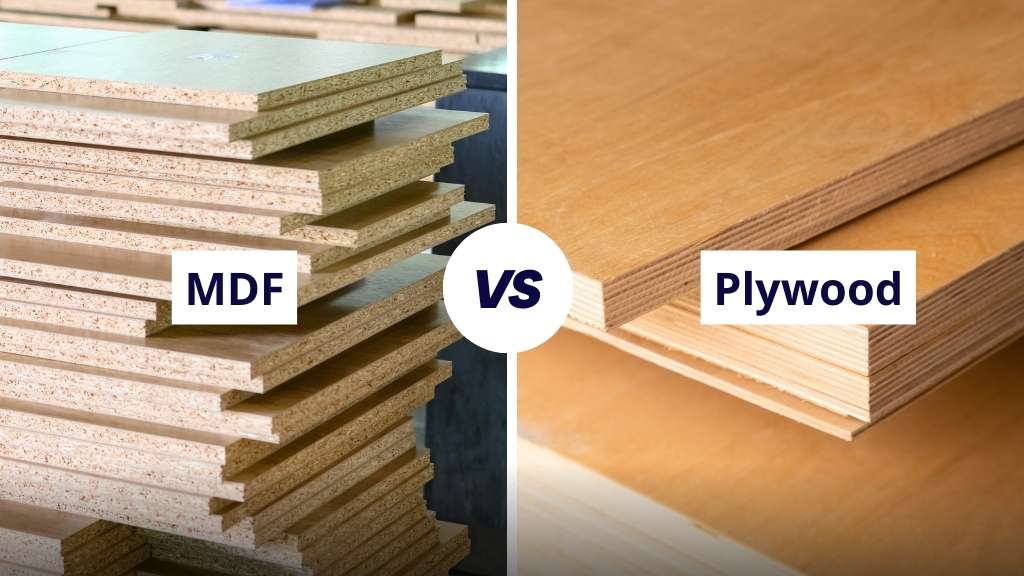Property Geek
We provide the actual and accurate information with unbiased user driven reviews to our viewers, to help them see the best and find the best!
View posts
When it comes to choosing the right material for your woodworking projects or furniture construction, MDF (Medium Density Fiberboard) and plywood are two commonly considered options.
While they both have their own advantages and applications, understanding the differences between MDF and plywood is crucial for making an informed decision. In this blog, we will delve into the characteristics, strengths, weaknesses, and best uses of MDF and plywood, helping you choose the most suitable material for your specific needs.
So, how to know what’s better between MDF vs plywood? Let’s understand that from the blog below.
Medium Density Fiberboard (MDF) is an engineered wood product made by breaking down wood fibers and combining them with a resin binder under high temperature and pressure. The resulting board is dense, uniform, and smooth, with no grain or knots. MDF is available in various thicknesses and is commonly used in furniture manufacturing, cabinetry, and interior applications.
Plywood, on the other hand, is a panel made from thin layers of wood veneers glued together with the grains of each layer running perpendicular to the adjacent layers. This cross-layer construction enhances the strength and stability of the board. Plywood comes in different grades, sizes, and thicknesses, and it is widely used in construction, furniture making, and exterior applications.
– Structural stability: Plywood’s cross-layered construction provides excellent strength and stability, making it suitable for applications requiring load-bearing capacity and resistance to warping or twisting.
– Moisture resistance: While not entirely waterproof, certain types of plywood, such as marine-grade plywood, offer superior resistance to moisture and can withstand humid or wet environments.
– Versatility: Plywood comes in various grades, ranging from construction-grade to high-quality hardwood options, offering versatility for different projects and budgets.
– Greater screw holding: Plywood’s layered structure gives it superior screw holding capacity compared to MDF, making it more suitable for applications where screws or fasteners are essential.
– Surface imperfections: Plywood can have visible wood grain, patches, or voids in the outer layers, requiring additional preparation, such as sanding or filling, before painting or finishing.
– Cost variability: Depending on the grade and type of plywood, the cost can vary significantly. High-quality hardwood plywood tends to be more expensive than MDF.
– Complexity in machining: Plywood can be more challenging to work with intricate designs or fine details due to its layered construction, which may require specialized cutting or joining techniques.
Choosing between MDF and plywood depends on the specific requirements of your project. If you need a smooth, uniform surface or a cost-effective option for indoor furniture or cabinetry, MDF is a suitable choice.
On the other hand, if structural strength, stability, or moisture resistance are crucial, plywood is the preferred material. By understanding the strengths, weaknesses, and best applications of MDF and plywood, you can make an informed decision and achieve the desired results in your woodworking endeavors. Now, you may have got a clear understanding of MDF vs plywood.
No, MDF is not recommended for outdoor applications. It is highly susceptible to moisture and will swell, break down, or deteriorate when exposed to water or high humidity. For outdoor projects, plywood or other suitable materials that offer better moisture resistance should be used.
Yes, plywood can be painted or finished easily. However, it is important to note that plywood may have surface imperfections such as wood grain, patches, or voids, which may require some preparation work such as sanding or filling before painting or finishing to achieve a smooth and uniform appearance.
No, plywood generally has better structural strength than MDF. Plywood’s cross-layered construction provides enhanced stability and load-bearing capacity, making it suitable for applications where strength is required. MDF, on the other hand, is not as strong and can be prone to sagging or breaking when subjected to heavy loads or stress.